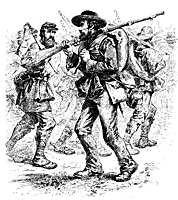Pierce Ferriter: Our Great Patron
Piaras Feiritear, better known via the Anglicized name Pierce Ferriter, was an Irish poet who also served as an officer during the War of the Irish Confederacy, 1641 – 1652. Piaras may have been born about the year 1600, the son of Eamon Feiritear, (Edmond Ferriter)a landowner whose lands on the far western part of the Dingle Peninsula had been the Ferriter family’s homestead for about 350 years when Pierce was born.
Much of what is known or surmised regarding Pierce Ferriter the man extends from his surviving poetry. His use of the Irish language, themes, and imagery indicates that he was a man of education, and probably well taught in both English and Irish. By account he was a harpist as well as a poet. The surviving body of work represents some of the finest Irish language poetry of his era.
Less is known of his personal life. Evidence exists that he was married and from this marriage, there is known to have been children: two sons and a daughter, Dominick, Richard, and Helen. We also know that Piaras was friendly with both the nearby family of the Knight of Kerry, who were Geraldines, and the more distant FitzMaurice family – also a Geraldine line. From the Lord of Kerry (FitzMaurice) he was favored with a commission to raise an armed company from his lands and neighborhood on the Dingle Peninsula. Pierce’s arming and leading of the local citizens was to be in support of the English Crown however, rather than going to war with the Kerry Catholics, he aligned himself with the anti-English forces, and brought his men to join in the siege of Tralee in 1641.
During the siege of Tralee Peirce was wounded, and his active involvement in the fighting after the fall of Tralee is uncertain. With the fall of Ross Castle in 1652, the war in Kerry was lost, and other defeats brought the war to an end in the rest of Ireland as well. Pierce Ferriter’s sons Dominick and Richard left Ireland as “Wild Geese” under agreements made by Lord Muskerry. Pierce remained at large for almost a year, and many of the folk tales and legends surrounding his abilities as a warrior emerge from this interval. At last, in 1653, Pierce Ferriter was brought in to Ross Castle under an assurance of safety.
After an unsuccessful parley was Pierce began his journey from Killarney homeward. Somewhere near Castledrum, he was apprehended by men dispatched by the erstwhile negotiator, Colonel Nelson, and brought back as prisoner. Pursuant to a trial of which no record remains, Piaras Ferriter was hanged, presumably for having been a rebel.
Know Your Ancestors
James T. Ferriter
James Thomas Ferriter was born in December, 1843, either in New York or Massachusetts to Irish immigrant parents. Most census data lists his birthplace as Massachusetts. It is quite likely that he was born in West Springfield, MA, as he had a brother, Patrick, who was born there in 1849. His parents, Patrick Ferriter and Catherine Sullivan Ferriter, had married in Ireland on February 14, 1840. They moved to America and travelled where there were railroads to be built. Patrick's family landed in Dummerston, Vermont, in 1850, where many people with Irish surnames and the job title of 'railroad laborer' are listed in the census.... Read More

